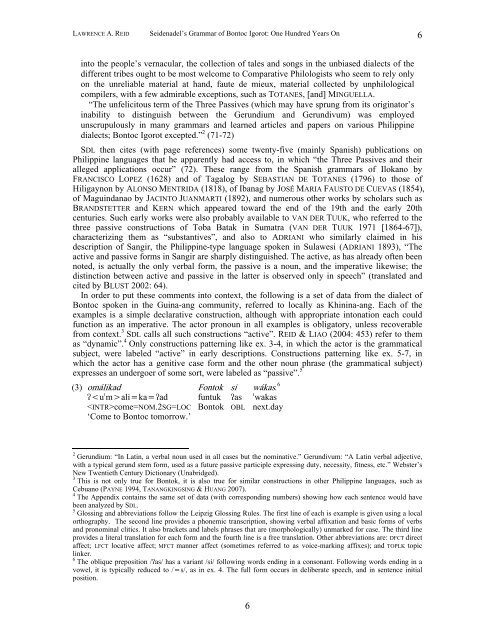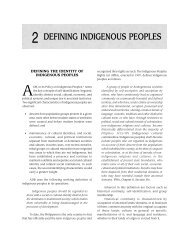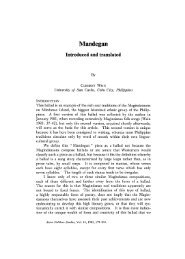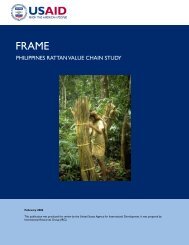1 Seidenadel's Grammar of Bontoc Igorot: One Hundred Years On
1 Seidenadel's Grammar of Bontoc Igorot: One Hundred Years On
1 Seidenadel's Grammar of Bontoc Igorot: One Hundred Years On
- No tags were found...
You also want an ePaper? Increase the reach of your titles
YUMPU automatically turns print PDFs into web optimized ePapers that Google loves.
LAWRENCE A. REID Seidenadel’s <strong>Grammar</strong> <strong>of</strong> <strong>Bontoc</strong> <strong>Igorot</strong>: <strong><strong>On</strong>e</strong> <strong>Hundred</strong> <strong>Years</strong> <strong>On</strong> 6<br />
into the people’s vernacular, the collection <strong>of</strong> tales and songs in the unbiased dialects <strong>of</strong> the<br />
different tribes ought to be most welcome to Comparative Philologists who seem to rely only<br />
on the unreliable material at hand, faute de mieux, material collected by unphilological<br />
compilers, with a few admirable exceptions, such as TOTANES, [and] MINGUELLA.<br />
“The unfelicitous term <strong>of</strong> the Three Passives (which may have sprung from its originator’s<br />
inability to distinguish between the Gerundium and Gerundivum) was employed<br />
unscrupulously in many grammars and learned articles and papers on various Philippine<br />
dialects; <strong>Bontoc</strong> <strong>Igorot</strong> excepted.” 2 (71-72)<br />
SDL then cites (with page references) some twenty-five (mainly Spanish) publications on<br />
Philippine languages that he apparently had access to, in which “the Three Passives and their<br />
alleged applications occur” (72). These range from the Spanish grammars <strong>of</strong> Ilokano by<br />
FRANCISCO LOPEZ (1628) and <strong>of</strong> Tagalog by SEBASTIAN DE TOTANES (1796) to those <strong>of</strong><br />
Hiligaynon by ALONSO MENTRIDA (1818), <strong>of</strong> Ibanag by JOSÉ MARIA FAUSTO DE CUEVAS (1854),<br />
<strong>of</strong> Maguindanao by JACINTO JUANMARTI (1892), and numerous other works by scholars such as<br />
BRANDSTETTER and KERN which appeared toward the end <strong>of</strong> the 19th and the early 20th<br />
centuries. Such early works were also probably available to VAN DER TUUK, who referred to the<br />
three passive constructions <strong>of</strong> Toba Batak in Sumatra (VAN DER TUUK 1971 [1864-67]),<br />
characterizing them as “substantives”, and also to ADRIANI who similarly claimed in his<br />
description <strong>of</strong> Sangir, the Philippine-type language spoken in Sulawesi (ADRIANI 1893), “The<br />
active and passive forms in Sangir are sharply distinguished. The active, as has already <strong>of</strong>ten been<br />
noted, is actually the only verbal form, the passive is a noun, and the imperative likewise; the<br />
distinction between active and passive in the latter is observed only in speech” (translated and<br />
cited by BLUST 2002: 64).<br />
In order to put these comments into context, the following is a set <strong>of</strong> data from the dialect <strong>of</strong><br />
<strong>Bontoc</strong> spoken in the Guina-ang community, referred to locally as Khinina-ang. Each <strong>of</strong> the<br />
examples is a simple declarative construction, although with appropriate intonation each could<br />
function as an imperative. The actor pronoun in all examples is obligatory, unless recoverable<br />
from context. 3 SDL calls all such constructions “active”. REID & LIAO (2004: 453) refer to them<br />
as “dynamic”. 4 <strong>On</strong>ly constructions patterning like ex. 3-4, in which the actor is the grammatical<br />
subject, were labeled “active” in early descriptions. Constructions patterning like ex. 5-7, in<br />
which the actor has a genitive case form and the other noun phrase (the grammatical subject)<br />
expresses an undergoer <strong>of</strong> some sort, were labeled as “passive”. 5<br />
(3) omálikad Fontok si wákas. 6<br />
ʔali=ka=ʔad funtuk ʔas ˈwakas<br />
come=NOM.2SG=LOC Bontok OBL next.day<br />
‘Come to <strong>Bontoc</strong> tomorrow.’<br />
2 Gerundium: “In Latin, a verbal noun used in all cases but the nominative.” Gerundivum: “A Latin verbal adjective,<br />
with a typical gerund stem form, used as a future passive participle expressing duty, necessity, fitness, etc.” Webster’s<br />
New Twentieth Century Dictionary (Unabridged).<br />
3 This is not only true for Bontok, it is also true for similar constructions in other Philippine languages, such as<br />
Cebuano (PAYNE 1994, TANANGKINGSING & HUANG 2007).<br />
4 The Appendix contains the same set <strong>of</strong> data (with corresponding numbers) showing how each sentence would have<br />
been analyzed by SDL.<br />
5 Glossing and abbreviations follow the Leipzig Glossing Rules. The first line <strong>of</strong> each is example is given using a local<br />
orthography. The second line provides a phonemic transcription, showing verbal affixation and basic forms <strong>of</strong> verbs<br />
and pronominal clitics. It also brackets and labels phrases that are (morphologically) unmarked for case. The third line<br />
provides a literal translation for each form and the fourth line is a free translation. Other abbreviations are: DFCT direct<br />
affect; LFCT locative affect; MFCT manner affect (sometimes referred to as voice-marking affixes); and TOPLK topic<br />
linker.<br />
6 The oblique preposition /ʔas/ has a variant /si/ following words ending in a consonant. Following words ending in a<br />
vowel, it is typically reduced to /=s/, as in ex. 4. The full form occurs in deliberate speech, and in sentence initial<br />
position.<br />
6

















